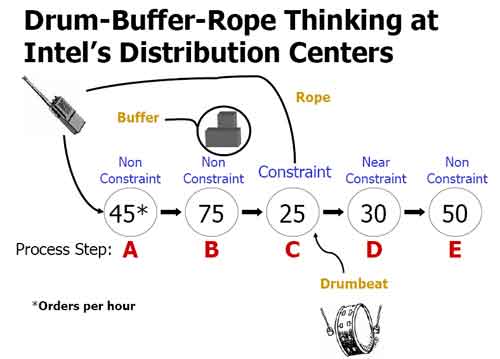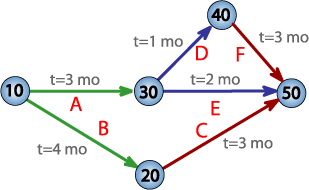The Theory of Constraints (TOC) is a systems philosophy from Eliyahu Moshe Goldratt, an Israeli physicist who became an American management guru. One of the things I enjoy about Dr. Goldratt is that he comes from a Rabbinical family, so he often communicates the findings of a physicist and a systems analyst in the manner of a Rabbi's teaching, usually through illustrative stories.
Here's a story about how TOC (at a very rudimentary level) is used in a manufacturing situation at Acme Widgets.
My amateurish example, of course, only scratches the surface of the Theory of Constraints, which has a robust set of tools and philosophies to make the concept usable. TOC is most often used in manufacturing, but the techniques of TOC apply to many fields.
- The Loading Docks can unload 25 tons of raw materials a day.
- Assembly can take in 20 tons of raw materials and produce 1000 widgets per day
- The Paint shop can paint 500 widgets a day.
- The Pack&Ship department can ship 800 widgets a day.
The Loading Docks are a scene of great complexity and most of the factory's problems. Materials arrive in railroad cars and trucks. Forklifts move pallets off the trains and trucks. Most conflict and injury happens on the Loading Docks. There are accidents between the forklifts driving around with their pallets and the pickup trucks carrying assembled widgets to the Paint Shop.
Based on current demand, the factory is producing and shipping about 400 widgets/day. A new Army contract means they need to increase output to 1000 widgets a day. While this is a great opportunity, Management knows they need to make investments and make changes to produce so many more widgets a day. The Board has arranged financing of $5 million/year for the scaleup.
At a manager's meeting, the CEO asks the managers, how do we spend the $5 million to scale up up to 1000 widgets/day? The production manager, the facilities manager, and the HR and Legal departments all agree: solve the problem on the Loading Docks. A redesigned layout will reduce congestion and confusion, reduce accidents, and make everything run more smoothly.
The CEO is pleased; he didn't think the managers would agree on a solution so easily. He asks, Anybody got anything else to say? Smithers, an old timer who'd been there longer than anybody else, spoke up and said, "You can spend the $5 million on the loading docks, and you'll get a beautiful, efficient facility. State of the art; something to be proud of. However, you will at most increase production by only 25%, and you will only satisfy half of the total demand."
There was an awkward moment of silence; usually, Smithers did not speak up at meetings. After the silent moment, they found their voices and started challenging Smithers. How could he know this? What was his basis? Didn't he see the confusion and congestion on the loading dock every day? The group had almost convinced itself that old Smithers was just too resistant to change, and he wasn't embracing the new paradigm. Then the CEO asked, "Smithers, tell me why you think that way".
Smithers said, "I know the Loading Dock is very visible to you all, and you see all the gritty happenings from your windows. But that's the nature of a loading dock. I also know that our paint shop is the limiting factor in our production capability. The paint shop can only paint 500 widgets a day; that's the choke point. We can only Pack & Ship 800 widgets a day, but that's a secondary constraint. The paint shop is your real problem."
Now the room was silent; he had their attention. "If you study it, you'll see that the Loading Dock is completely capable of handling the increased volume. Assembly will be right at capacity at 1000 widgets/day.
Smithers continued, "You need to double the capacity of the Paint Shop, and increase the capacity of Pack&Ship by 20%. If you run two shifts in the paint shop, you can paint 1000 widgets a day. You'll probably need to boost the Pack&Ship department with overtime to go from 800/day to 1000/day.
"Total cost over a year will be about $1 million. If you decide to spend a half-million organizing the Loading Docks, that's not a bad idea, it'll reduce accidents and injuries. But the necessity is: you've got to focus on the constraints."
The board quickly agreed. After the meeting, the CEO signaled Smithers to wait a moment. The CEO asked, "Smithers, how did we come so close to making a catastropic mistake?"
Smithers answered, "Well, boss, they're all good people. The Loading Dock is outdoors and in the weather, and Facilities has most of their problems out there. Production sees the complexity and disarray, and he'd really like to get it all organized but he doesn't know how. HR and Legal hate dealing with the Union out there, and they're legitimately concerned that the Loading Dock is the only place where injuries happen. A sparkling new loading dock just appealed to their needs, and you know that Acme LoadDockCo's has been trying to sell an overhaul to them for a while. I think they were a big sponsor at last year's golf tournament. Problem is, it just doesn't address the operational constraint."
The primary constraint in aviation delays and congestion is the runway. You can deliver 300 airplanes an hour to the terminal airspace using satellites and altitudes and all the technology, but if the runway acceptance rate is 60 airplanes/hour, you're only going to land 60 an hour. Runways are the constraint.

Drum - Buffer - Rope
TOC can teach us more about managing the constraint. The primary TOC mindset for managing a constrained system is called "Drum - Buffer - Rope" (DBR), and it would be informative to see how that might apply to the problem of aviation delays. Remember that in our scenario, the takeoff and landing runways are the constraint.The drum is the physical constraint of the system: the component or operation that limits the ability of the entire system to produce more. The entire system must march to the beat of the drum. We optimize the situation by making sure the drum has work to do, and that anything the drum has processed does not get wasted. In our application, making sure the drum has work to do means never leaving a gap on the runway unused, and avoiding waste (for instance) means avoiding go-arounds which waste an opportunity.
The buffer protects the drum from inactivity, so that it always has work flowing to it. Buffers in DBR have time as their unit of measure, rather than quantity of material. This makes the priority system operate strictly based on the time an order is expected to be at the drum. In aviation, the buffer is a queue of aircraft waiting to takeoff and land; having a small buffer available ensures that the drum (runway) will be used as efficiently as possible.
The rope is the work release mechanism for the plant. Only a "buffer time" before an order is due does it get released into the plant. Pulling work into the system earlier than a buffer time guarantees high work-in-process (WIP), gridlocks the entire system, and increases errors.
There are implications of Drum-Buffer-Rope throughout our aviation system.


Critical Path Method vs Theory of Constraints
Another technique that closely parallels the TOC philosophy and the Drum-Buffer-Rope technique is Critical Path Method (CPM) of project management.
In this example of a multi-dimensional work process with both interdependent and non-dependant activities, the minimum time for project completion is seven months. There are two critical paths, in which any delay will result in a delay of the project.
- Critical Paths:
- Activity B and dependant Activity C (seven months)
- Activity A, dependant Activity D, and dependant Activity F (seven months)
Because they are on the critical path, any delay in B,C,A,D or F will result in a delay in project completion.
Note that Activity E, which takes two months, is not on any critical path. Activity E has a float of two months, which means that E could take as long as four months without delaying the project. This understanding gives project managers some priorities in responding to challenges; a two-week delay on Activity E is not any cause for concern.
In our application, the takeoff and departure runways are the critical path; any delay at either results in a delay of the flight.
Some critics of TOC contend that TOC merely repackages multipath CPM concepts into linear manufacturing applications. For me, I think TOC presents time and capacity issues with more nuance and flexibility than I see in CPM.





2 comments:
Thank you -- thank you -- thank you. GREAT work.
Don Brown
http://gettheflick.blogspot.com/
Once again fantastic article. You appear to have a great comprehension of these themes or templates.While i going into your website,My spouse and i sensed this . Occur and make writting your blog could be more desirable. To Your Good results!
Post a Comment
Comments and Feedback? Love that stuff. Please leave your thoughts in the box below--